Held Hostage: Ingrid Betancourt's Survival Story
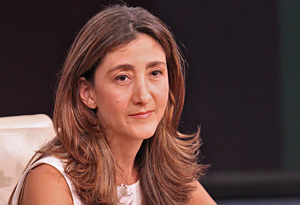
Photo: George Burns/Harpo Studios
Picture the Amazon rainforest—while the images of this massive jungle are often beautiful and breathtaking, in reality it's a hostile and deadly place. Dark, steamy and wet, the rainforest is alive with more stinging, biting and swarming insects than any other place on earth. Scorpions, beetles, wasps, spiders and hundreds of different types of tarantulas flourish in the humidity. The threat of yellow fever, malaria and typhoid is ever present. Rivers teem with leeches, piranhas, electric eels, crocodiles and 20-foot anacondas. Jaguars, mountain lions, wild boars and more than 100 species of snakes thrive in the Amazon.
After being kidnapped at gunpoint by Colombian rebels and held as a hostage, Ingrid Betancourt spent an agonizing six and a half years in this jungle, not knowing if it would become her grave.
For the first time since her nail-biting rescue in 2008, Ingrid reveals the intimate details of her captivity in her memoir, Even Silence Has an End. "I have never heard a more incredible story of survival, of strength, of courage in my life," Oprah says.
After being kidnapped at gunpoint by Colombian rebels and held as a hostage, Ingrid Betancourt spent an agonizing six and a half years in this jungle, not knowing if it would become her grave.
For the first time since her nail-biting rescue in 2008, Ingrid reveals the intimate details of her captivity in her memoir, Even Silence Has an End. "I have never heard a more incredible story of survival, of strength, of courage in my life," Oprah says.
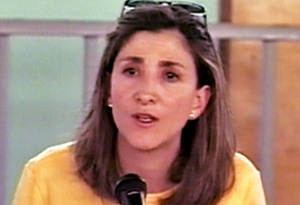
Photo: Radio Cedena Nacional Television
Ingrid's story begins in France, where she attended school, married and started a family. In 1989 she returned to her native Colombia and was elected as a senator. With an anti-corruption stance, she launched her bid for president of the war-torn country in 2002.
For nearly 50 years, Colombia has been waging a war against the Revolutionary Armed Forces of Colombia, a home-grown rebel group known as the FARC. This organization has terrorized citizens for decades with bombings, murders and thousands of kidnappings.
During her presidential campaign, Ingrid met with FARC leaders and made a demand. "No more kidnappings," she said. "That the FARC promises to stop kidnapping and to free the kidnapped people."
On February 23, 2002, just days after she made that statement, Ingrid headed to the Colombian city of San Vicente for a campaign stop. The town was located in a region controlled by the FARC, and the Colombian military says they cautioned Ingrid against traveling to this dangerous area, even refusing to provide her with armed escorts. Despite the warnings, Ingrid decided to make the trip with her campaign manager, Clara Rojas, another staffer and two journalists.
For nearly 50 years, Colombia has been waging a war against the Revolutionary Armed Forces of Colombia, a home-grown rebel group known as the FARC. This organization has terrorized citizens for decades with bombings, murders and thousands of kidnappings.
During her presidential campaign, Ingrid met with FARC leaders and made a demand. "No more kidnappings," she said. "That the FARC promises to stop kidnapping and to free the kidnapped people."
On February 23, 2002, just days after she made that statement, Ingrid headed to the Colombian city of San Vicente for a campaign stop. The town was located in a region controlled by the FARC, and the Colombian military says they cautioned Ingrid against traveling to this dangerous area, even refusing to provide her with armed escorts. Despite the warnings, Ingrid decided to make the trip with her campaign manager, Clara Rojas, another staffer and two journalists.
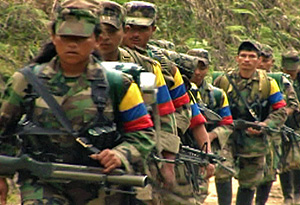
Photo: Getty Images
Thirty miles into the drive toward San Vincente, Ingrid's car approached a checkpoint manned by FARC guerrillas. "I told the driver: 'Let's go back. We have to get out of here,'" Ingrid says. "There was a guerrilla that came running, and he put his head inside the car and he asked, 'Are you Ingrid Betancourt?' And I said, 'Yes.'"
Ingrid and her campaign manager, Clara, were forced into a truck at gunpoint. "We had been abducted," Ingrid says. "The guerrilla didn't use the word 'kidnapped.' But he said, 'I have received orders from my commanders to treat you well.' That was, I would say, the worst day of my life."
For the next six and a half years, Ingrid was held hostage in the Colombian jungle, unable to see or speak to her husband and two children. She and her fellow hostages were often kept in what they called "the cage." Although the living space would change depending on where they camped in the jungle, Ingrid says lack of personal space was a big issue.
Ingrid says she shared a tiny space with Clara for the first year and a half. "We would pass all our days sitting in that space, and of course, every move we would do, we would just brush each other. It was very difficult," she says.
None of the hostages were allowed to do anything without first asking for permission, including using the bathroom. Called the "chuntas," Ingrid says her toilet was a hole dug in the ground that everyone used. "And, of course, all the bugs and all the things had their favorite place over there," she says. "It was horrible."
Ingrid and her campaign manager, Clara, were forced into a truck at gunpoint. "We had been abducted," Ingrid says. "The guerrilla didn't use the word 'kidnapped.' But he said, 'I have received orders from my commanders to treat you well.' That was, I would say, the worst day of my life."
For the next six and a half years, Ingrid was held hostage in the Colombian jungle, unable to see or speak to her husband and two children. She and her fellow hostages were often kept in what they called "the cage." Although the living space would change depending on where they camped in the jungle, Ingrid says lack of personal space was a big issue.
Ingrid says she shared a tiny space with Clara for the first year and a half. "We would pass all our days sitting in that space, and of course, every move we would do, we would just brush each other. It was very difficult," she says.
None of the hostages were allowed to do anything without first asking for permission, including using the bathroom. Called the "chuntas," Ingrid says her toilet was a hole dug in the ground that everyone used. "And, of course, all the bugs and all the things had their favorite place over there," she says. "It was horrible."
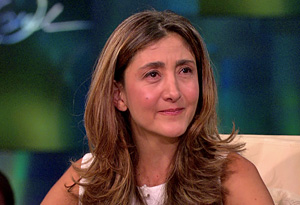
Despite threat of punishment—and sometimes death—Ingrid defied her captors and attempted to escape on many occasions. In Even Silence Has an End, Ingrid writes in detail about these failed attempts and says that each time she was caught trying to flee, the punishments grew worse.
Once, after she was re-captured, Ingrid says she was beaten by the guerrillas. Then, she says they put a chain around her neck and walked her back to camp like a dog.
Read about one of her escape attempts.
After awhile, Ingrid says that the fear of getting caught was worse than the fear of dying. "I especially thought that perhaps [death] was like freedom," Ingrid says. "Especially because the burden of the pain I was causing to my family was just unbearable."
Ingrid says her family was her sun, moon and stars, but she felt as if she had frozen their lives. "[I thought], 'They cannot move on because they're waiting for me. And this could last for 20 more years,'" she says.
When Ingrid was kidnapped in 2002, her son, Lorenzo, was 13 years old and her daughter, Melanie, was 16 years old. "I had to just try to imagine how they had transformed themselves. I would close my eyes and try to just project the face of Melanie into a more mature girl and then woman, and of my little boy to a man with another voice," she says.
Once, after she was re-captured, Ingrid says she was beaten by the guerrillas. Then, she says they put a chain around her neck and walked her back to camp like a dog.
Read about one of her escape attempts.
After awhile, Ingrid says that the fear of getting caught was worse than the fear of dying. "I especially thought that perhaps [death] was like freedom," Ingrid says. "Especially because the burden of the pain I was causing to my family was just unbearable."
Ingrid says her family was her sun, moon and stars, but she felt as if she had frozen their lives. "[I thought], 'They cannot move on because they're waiting for me. And this could last for 20 more years,'" she says.
When Ingrid was kidnapped in 2002, her son, Lorenzo, was 13 years old and her daughter, Melanie, was 16 years old. "I had to just try to imagine how they had transformed themselves. I would close my eyes and try to just project the face of Melanie into a more mature girl and then woman, and of my little boy to a man with another voice," she says.
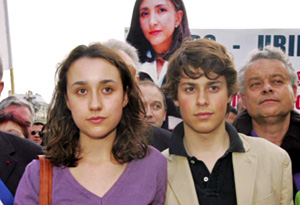
Photo: Getty Images
At home, Ingrid's family and friends were working tirelessly to secure her release. Lorenzo and Melanie joined supporters at rallies and protests in France and Colombia, hoping to keep their mother's memory alive. They even lobbied the president of France on their mother's behalf.
The family was able to send love and support to Ingrid through a Colombian radio program devoted to broadcasting messages to the nearly 700 hostages being held across the country. Ingrid's mother, Yolanda, called into the radio show almost daily. "The only way I had to help her was to tell her every day how much I loved her," Yolanda says.
Not everyone in Ingrid's life had a chance to show their support and send well-wishes. Exactly one month after her abduction, Ingrid's father, whom she says she adored, passed away. "I was abducted at 1 p.m. the 23rd of February. He died the 23rd of March, 1 p.m.," Ingrid says.
The family was able to send love and support to Ingrid through a Colombian radio program devoted to broadcasting messages to the nearly 700 hostages being held across the country. Ingrid's mother, Yolanda, called into the radio show almost daily. "The only way I had to help her was to tell her every day how much I loved her," Yolanda says.
Not everyone in Ingrid's life had a chance to show their support and send well-wishes. Exactly one month after her abduction, Ingrid's father, whom she says she adored, passed away. "I was abducted at 1 p.m. the 23rd of February. He died the 23rd of March, 1 p.m.," Ingrid says.

During the six and a half years Ingrid was held captive, the FARC released three videos to prove to the outside world that she was still alive.
Watch Ingrid's proof-of-life videos, filmed by the FARC.
The first video was released to the media just five months after her capture, but then, a year went by before the second video was made public. In 2007, the final video was shot, but Ingrid says she wanted no part in it. Five years in captivity had taken its toll, and in the third and final video, the world saw a frail Ingrid quietly sitting somewhere deep in the Amazon jungle, refusing to speak or even look at the camera.
Other than the proof-of-life videos, Melanie says the family had no way of knowing if her mother was still alive, and she couldn't move on with her life. "I think you cannot move on," she says. "You cannot mourn when you don't know."
Watch Ingrid's proof-of-life videos, filmed by the FARC.
The first video was released to the media just five months after her capture, but then, a year went by before the second video was made public. In 2007, the final video was shot, but Ingrid says she wanted no part in it. Five years in captivity had taken its toll, and in the third and final video, the world saw a frail Ingrid quietly sitting somewhere deep in the Amazon jungle, refusing to speak or even look at the camera.
Other than the proof-of-life videos, Melanie says the family had no way of knowing if her mother was still alive, and she couldn't move on with her life. "I think you cannot move on," she says. "You cannot mourn when you don't know."

The day Ingrid and her 14 fellow hostages were finally rescued reads like fiction. For months leading up to this day in July 2008, members of the Colombian military posed as FARC terrorist commanders and hacked into the guerrillas' radio exchanges. These special forces soldiers also took acting lessons so they could pass as aid workers in charge of transporting the group.
Using the FARC radio transmissions, the soldiers ordered Ingrid's captors to transport her and the 14 other hostages to another camp, where they would supposedly meet the new rebel leader.
The hostages were handcuffed and loaded onto a helicopter while dozens of armed guerrillas stood by and watched. None of the hostages were in on the plan, and Ingrid says she believed she was being taken to another location where she would be held for many more years.
Once they were in the air, special forces soldiers announced to Ingrid and the 14 other hostages that they were finally free. "I didn't understand what was happening," Ingrid says. "Then one of the guys, he took off his cap, he threw it in the air, and he said: 'We are the Colombian Army. You are free!'"
Watch the daring rescue mission
While flying over the dense jungle, Ingrid says the sudden shock of freedom was a scary feeling. "It was very frightening because there was no preparation for that," she says. "It was that kind of very strong, strong release of energy. We were all shouting, crying."
Using the FARC radio transmissions, the soldiers ordered Ingrid's captors to transport her and the 14 other hostages to another camp, where they would supposedly meet the new rebel leader.
The hostages were handcuffed and loaded onto a helicopter while dozens of armed guerrillas stood by and watched. None of the hostages were in on the plan, and Ingrid says she believed she was being taken to another location where she would be held for many more years.
Once they were in the air, special forces soldiers announced to Ingrid and the 14 other hostages that they were finally free. "I didn't understand what was happening," Ingrid says. "Then one of the guys, he took off his cap, he threw it in the air, and he said: 'We are the Colombian Army. You are free!'"
Watch the daring rescue mission
While flying over the dense jungle, Ingrid says the sudden shock of freedom was a scary feeling. "It was very frightening because there was no preparation for that," she says. "It was that kind of very strong, strong release of energy. We were all shouting, crying."

Photo: George Burns/Harpo Studios
After her release, Ingrid was celebrated as a hero and awarded France's highest honor by President Nicolas Sarkozy...but some of Ingrid's fellow hostages saw things very differently. Keith Stansell and others alleged that Ingrid was arrogant and bossy in captivity and that she took more than her fair share of food. "Ingrid Betancourt, to me, is the most disgusting human being I've ever encountered in my life," Keith said in an interview.
Even Ingrid's former campaign manager, Clara Rojas, clashed with Ingrid in captivity. In her memoir, Clara wrote that Ingrid went "from being a role model to someone who represented death, becoming extremely apathetic and bitter."
In Vanity Fair magazine, fellow hostage Gloria Polanco expressed her feelings very bluntly, saying, "Let's not make symbols and icons out of women who aren't."
Ingrid says she can see the validity in their criticism. "I understand why they didn't like me, and honestly, I wasn't perfect," she says. "Of course, we're in that camp living together. Everything was nasty. No space. We were fighting for a tree where to hang our hammocks, stupid things. It was our life."
Even Ingrid's former campaign manager, Clara Rojas, clashed with Ingrid in captivity. In her memoir, Clara wrote that Ingrid went "from being a role model to someone who represented death, becoming extremely apathetic and bitter."
In Vanity Fair magazine, fellow hostage Gloria Polanco expressed her feelings very bluntly, saying, "Let's not make symbols and icons out of women who aren't."
Ingrid says she can see the validity in their criticism. "I understand why they didn't like me, and honestly, I wasn't perfect," she says. "Of course, we're in that camp living together. Everything was nasty. No space. We were fighting for a tree where to hang our hammocks, stupid things. It was our life."
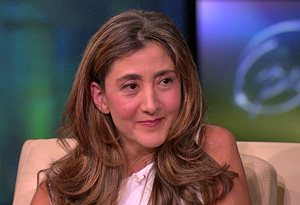
Ingrid says she doesn't have any hard feelings toward her fellow captives, despite what they have said. In fact, she says she thinks of them as family.
"I haven't spent, in my life, so much time with anybody—not my children or my mom or anybody—than with them. And I love them," she says. "I hope they will just process what they lived in a different way, and they will just change their minds. But it doesn't matter."
Ingrid says she's made peace with most of the former hostages and speaks with many of them. Toward the end of Even Silence Has an End, Ingrid alludes to a romantic relationship with a fellow hostage named Marc. "Well, let's say that I had a very special relationship with Marc," Ingrid says. "I think it was love."
"I haven't spent, in my life, so much time with anybody—not my children or my mom or anybody—than with them. And I love them," she says. "I hope they will just process what they lived in a different way, and they will just change their minds. But it doesn't matter."
Ingrid says she's made peace with most of the former hostages and speaks with many of them. Toward the end of Even Silence Has an End, Ingrid alludes to a romantic relationship with a fellow hostage named Marc. "Well, let's say that I had a very special relationship with Marc," Ingrid says. "I think it was love."
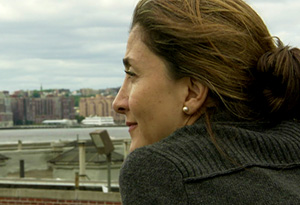
Now, Ingrid says she cherishes all the small freedoms she was refused as a hostage, like shopping at the supermarket or going for a long walk. "To have my own space is something I really appreciate," she says. "Not having to fight for the space. The little things of freedom like being about to just change your mind. Those kind of little decisions you make every day, I really cherish them a lot."
Watch and see what Ingrid's life is like now.
The biggest lesson Ingrid says she learned came to her once she felt she had lost everything. "I couldn't move. I couldn't go to the toilet. I couldn't drink when I wanted. I couldn't talk to anybody. I couldn't do anything without permission. And there I was, chained to a tree, with pouring rain over me, thinking I was less than an animal," she says. "Then I thought: 'No, that's not true—there's something left. I have the freedom to choose what kind of person I want to be.'"
Read an excerpt from Ingrid's memoir Even Silence Has an End
Watch and see what Ingrid's life is like now.
The biggest lesson Ingrid says she learned came to her once she felt she had lost everything. "I couldn't move. I couldn't go to the toilet. I couldn't drink when I wanted. I couldn't talk to anybody. I couldn't do anything without permission. And there I was, chained to a tree, with pouring rain over me, thinking I was less than an animal," she says. "Then I thought: 'No, that's not true—there's something left. I have the freedom to choose what kind of person I want to be.'"
Read an excerpt from Ingrid's memoir Even Silence Has an End



